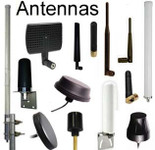Antennas, Antenna Cables, Wireless Products: Technical Articles
Cellular Micro Base Stations Enhanced Coverage; Compact Size
Table of Contents
Cellular Micro Base Stations Enhanced Coverage / Compact Size
The Micro Base Station market is experiencing significant growth, driven by the increasing demand for enhanced cellular coverage, especially in densely populated urban areas. These compact base stations are pivotal in supporting the expansion of 5G networks, providing the infrastructure necessary for high-speed, reliable connectivity.DataIntelo+1Business Research Insights+1Business Research Insights

Market Size and Growth Forecast
Current Market Size: As of 2023, the global micro base station market was valued at approximately USD 2.5 billion. DataIntelo
Projected Growth: The market is anticipated to reach USD 7.8 billion by 2032, exhibiting a Compound Annual Growth Rate (CAGR) of 13.5% during the forecast period. DataIntelo+2DataIntelo+2Business Research Insights+2
Key Suppliers and Operating Conditions
Several prominent companies are actively contributing to the micro base station market:
Huawei Technologies Co., Ltd.: A leading global provider of telecommunications equipment, Huawei has been instrumental in deploying 5G infrastructure worldwide.
Ericsson: This Swedish multinational networking company has been at the forefront of 5G technology, offering innovative solutions for network operators.
Nokia Corporation: Based in Finland, Nokia provides a comprehensive portfolio of network equipment, software, and services, playing a crucial role in 5G deployments.
ZTE Corporation: A Chinese multinational, ZTE offers advanced telecommunications systems and has been expanding its 5G base station offerings.
Samsung Electronics: The South Korean conglomerate has developed cutting-edge 5G solutions, including micro base stations, to enhance mobile network capabilities. cognitivemarketresearch.com
Accelleran: Specializes in small cell solutions, providing software and hardware for dense network deployments.
Airspan Networks: Offers wireless solutions, including micro base stations, to support mobile broadband networks.
Azcom Technology: Provides advanced communication solutions, including base station development for various applications.
Cambridge Communication Systems (CCS): Focuses on wireless backhaul solutions, essential for connecting micro base stations in urban environments.
Ceragon Networks: Specializes in wireless hauling solutions, ensuring high-capacity connectivity for base stations.
Cisco Systems: Offers a range of networking solutions, including those supporting micro base station infrastructure.
CommScope: Provides infrastructure solutions for communication networks, including components for base stations.
Gemtek Technology: Manufactures wireless broadband solutions, contributing to the micro base station market.
IP Access (Britain): Develops small cell technologies, enhancing mobile network coverage and capacity.
NuRAN Wireless (Canada): Offers mobile and broadband wireless infrastructure solutions, focusing on rural and remote areas.
SWOT Analysis (Strengths, Weaknesses, Opportunities, and Threats)
1. Strengths: What makes Micro Base Stations advantageous?

Compact Size & Flexible Deployment
- Easily installed in urban, rural, and indoor environments.
- Suitable for high-density areas where macro base stations struggle.
Enhanced Network Capacity & Coverage
- Supports high user traffic and improves coverage in blind spots.
- Reduces congestion in macro network infrastructure.
Essential for 5G & IoT Growth
- Supports high-speed, low-latency communications required for 5G networks.
- Ideal for Internet of Things (IoT) applications and smart city development.
Energy-Efficient & Cost-Effective
- Consumes less power than macro base stations.
- Reduces capital and operational costs, making it cost-efficient for network operators.
Low Latency & High Data Throughput
- Enhances real-time applications like autonomous vehicles, industrial automation, and cloud computing.
2. Weaknesses: Challenges or limitations of Micro Base Stations
Limited Coverage Range
- Typically covers a few hundred meters, requiring dense deployment in urban areas.
Interference in Dense Deployments
- Multiple micro base stations in close proximity can create signal interference.
High Initial Deployment Costs
- Although operational costs are low, initial investment in infrastructure can be significant.
Dependency on Backhaul Connectivity
- Requires a strong fiber or wireless backhaul network to function effectively.
Complex Network Management
- Requires advanced network management to ensure seamless handovers between base stations.
3. Opportunities: Growth potential and market expansion
5G Expansion & Ultra-Dense Networks
- Telecom operators are massively investing in small cells and micro base stations to support 5G rollouts.
Rising Demand for Smart Cities & IoT
- Governments and private firms are investing in smart city projects, which require dense 5G networks.
Rural & Remote Connectivity Initiatives
- Expanding coverage in rural areas presents a huge market opportunity, especially with government funding.
Increasing Edge Computing Adoption
- Micro base stations facilitate edge computing, reducing latency for applications like AR/VR and self-driving cars.
Private 5G Networks for Enterprises
- Large enterprises are deploying private 5G networks, driving demand for dedicated micro base station.
4. Threats: External risks affecting the Micro Base Station market
Regulatory & Spectrum Licensing Issues
- Governments control spectrum allocation, which can delay deployments and increase costs.
Technological Obsolescence
- Rapid innovation in 5G and beyond (e.g., 6G research) might make existing micro base station models outdated.
Security Concerns
- More network endpoints increase the risk of cyberattacks, making security a major concern.
Competition from Emerging Wireless Technologies
- Alternative technologies like satellite-based internet (Starlink) and Wi-Fi 6 could reduce dependence on small cell networks.
Trade Restrictions & Supply Chain Issues
- Geopolitical tensions (e.g., U.S.-China trade restrictions) can affect equipment availability from major players like Huawei and ZTE.
Imports and Exports of Major Countries
While specific import and export data for micro base stations are limited, the overall telecommunications equipment trade indicates:
China: A major exporter of telecommunications equipment, including base stations, due to its robust manufacturing capabilities.
United States and Europe: Significant importers of advanced telecommunications infrastructure to support their network expansions.
South Korea and Japan: Both export and import telecommunications equipment, reflecting their roles as technology producers and consumers.
Market Growth Opportunities and Future Forecasts
The micro base station market is poised for substantial growth, driven by:
5G Network Deployment: The global shift towards 5G technology necessitates dense network infrastructures, where micro base stations play a critical role.
Smart City Initiatives: Urban development projects focusing on smart infrastructure require reliable and widespread network coverage, boosting the demand for micro base stations.
Rural Connectivity: Efforts to bridge the digital divide are leading to deployments in rural and remote areas, expanding the market scope.
Conclusion
The cellular micro base station market is set for rapid expansion, fueled by the global demand for enhanced coverage, high-capacity 5G networks, and smart city development. While challenges such as limited range, deployment costs, and regulatory hurdles remain, the strengths of compact size, energy efficiency, and ability to support IoT and edge computing make micro base stations indispensable. With strong participation from major telecom suppliers and growing opportunities in both urban and rural connectivity, micro base stations will continue to play a central role in shaping the future of mobile communication infrastructure.
FAQs
What is driving the growth of the micro base station market?
The market is expanding due to rising demand for enhanced cellular coverage in urban areas, the global rollout of 5G networks, and increasing adoption of IoT and smart city initiatives. These compact base stations provide reliable, high-speed connectivity in places where traditional macro base stations are less effective.
How large is the global micro base station market, and what is its growth forecast?
As of 2023, the global micro base station market was valued at approximately USD 2.5 billion. It is projected to reach USD 7.8 billion by 2032, growing at a 13.5% CAGR during the forecast period.
Which companies are key players in the micro base station market?
Major suppliers include Huawei, Ericsson, Nokia, ZTE, and Samsung, along with specialized firms like Accelleran, Airspan Networks, Azcom Technology, CCS, Ceragon Networks, Cisco, CommScope, Gemtek, IP Access, and NuRAN Wireless. These companies drive innovation, deployment, and infrastructure development worldwide.
What are the main advantages of micro base stations?
Key strengths include compact size, flexible deployment, improved network capacity, energy efficiency, and support for 5G and IoT applications. They also reduce congestion in macro networks while enabling high-speed, low-latency communications for applications like autonomous vehicles and industrial automation.
What challenges do micro base stations face?
Limitations include short coverage range, interference in dense deployments, high initial deployment costs, dependency on backhaul connectivity, and complex network management. These challenges require careful planning and investment to overcome.
What opportunities exist for the micro base station market?
Opportunities include 5G expansion, smart city projects, rural connectivity initiatives, edge computing adoption, and private 5G networks for enterprises. These trends are expected to drive significant demand and innovation in the coming years.
What external threats could impact market growth?
The market faces risks from regulatory hurdles, spectrum licensing issues, rapid technological changes, cybersecurity concerns, competition from alternatives like satellite internet and Wi-Fi 6, and geopolitical trade restrictions that can affect equipment availability and supply chains.







